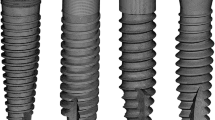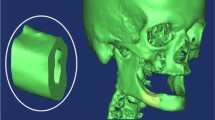Abstract
The study of the biomechanical behavior of a system of dental implant, abutment and surrounding bone is essential for a thorough understanding of the load transmission generated by masticatory forces, to develop and optimize the implant design. This article presents an accurate numerical model of implant-abutment-bone system which is subjected to a masticatory loading simulated by axial and horizontal forces acting on the abutment. It is presented a three-dimensional finite element method calculation of stress, displacement, and safety factor, highlighting the influence of bone quality and critical zones of stress concentration by a numerical model as close as possible to reality. The stress distribution pattern is influenced by the loading type and localization, rather than its intensity. Stress values obtained with oblique loading forces are higher than with vertical ones. The loads acting on the structure may cause damage, micro-cracks, and not immediate failure or rupture. The bone quality has an important influence, obtaining lower stress values when the bone is weaker and less resistant to deformation. The novelty of the study consists in developing exclusively by means of computer programs of a geometric model that respects exactly all dimensions and shapes of an actual implant. Once the geometric model of great accuracy is constructed, simulations of various clinical cases can be performed through various loads, various types of materials, boundary conditions, etc. Our study results are consistent with clinical studies observations and similar results from the literature, highlighting critical areas of high stresses at the implant neck and its surrounding bone, potentially responsible for implant failure.










Similar content being viewed by others
Abbreviations
- 3D:
-
Three dimensional
- FEM:
-
Finite element method
- FE:
-
Finite element
- FOS:
-
Factor of safety
References
Chatterjee S, Sarkar S, Kalidindi SR, Basu B (2019) Periprosthetic biomechanical response towards dental implants, with functional gradation, for single/multiple dental loss. J Mech Behav Biomed Mater 94:249–258. https://doi.org/10.1016/j.jmbbm.2019.03.001
Liang R, Guo W, Qiao X, Wen H, Yu M, Tang W, Liu L, Wei Y, Tian W (2015) Biomechanical analysis and comparison of 12 dental implant systems using 3D finite element study. Comput Meth Biomech Biomed Eng 18:1340–1348
Lee JS, Cho IH, Kim YS et al (2012) Bone-implant interface with simulated insertion stress around an immediately loaded dental implant in the anterior maxilla: a three-dimensional finite element analysis. Int J Oral Maxillofac Implants 27(2):295–302
Bahuguna R, Anand B, Kumar D, Aeran H, Anand V, Gulati M (2013) Evaluation of stress models in bone around dental implant for different blunt angulations under axial and oblique loading: a FE analysis. Natl J Maxillofac Surg 4:46–51
Vanegas-Acosta JC, Landinez PN, Garzon-Alvarado DA, Casale RM (2011) A finite element method approach for the mechanobiological modeling of the osseointegration of a dental implant. Comput Methods Programs Biomed 101:297–314
El-Anwar MI, El-Zawahry MM (2011) A three dimensional finite element study on dental implant design. J Genet Eng Biotechnol 9:77–82
Mathieu V, Vayron R, Richard G, Lambert G, Naili S, Meningaud JP, Haiat G (2014) Biomechanical determinants of the stability of dental implants: influence of the bone-implant interface properties. J Biomech 47:3–13
Huang YM, Chou IC, Jiang CP, Wu YS, Lee SY (2014) Finite element analysis of dental implant neck effects on primary stability and osseointegration in a type IV bone mandible. Biomed Mater Eng 24:1407–1415
Santos MBF, Silva Neto JP, Consani RLX, Mesquita MF (2011) Three-dimensional finite element analysis of stress distribution in peri-implant bone with relined dentures and different heights of healing caps. J Oral Rehab 38:691–696
Chen L (2012) Application of finite element analysis in implant dentistry. Finite element analysis of the stress on the implant-bone interface of dental implants with different structures. Finite element analysis—New trends and developments. Intech
Taharou B, Merdji A, Hillstrom R, Benaissa A, Roy S, Della N, Aid A, Mukdadi O (2021) Biomechanical evaluation of bone quality effect on stresses at bone-implant interface: a finite element study. J Appl Comput Mech 7(3):1266–1275. https://doi.org/10.22055/JACM.2020.32323.2005
Bhattacharyya S, Choudhury S, Datta P, Pal AK, Roy S, Chatterjee R, De R, Chakraborty A, Saha S, Chowdhury AR (2021) Assessment of jaw bone quality for designing patient-specific dental implant using computed tomography data. J Long Term Eff Med Implants 31(1):4958. https://doi.org/10.1615/JLongTermEffMedImplants.2021036995
Ouldyerou A, Merdji A, Aminallah L, Msomi V, Chong PL, Roy S (2022) biomechanical evaluation of marginal bone loss in the surrounding bone under different loading: 3d finite element analysis study. Int J Multiscale Comput Eng 20(4):43–56. https://doi.org/10.1615/IntJMultCompEng.2022043707
Roateşi I, Roatesi S (2020) Modeling of dental implant osseointegration progress by three-dimensional finite element method. Appl Sci 10:5561. https://doi.org/10.3390/app10165561
Giudice A, Bennardo F, Antonelli A, Barone S, Wagner F, Fortunato L, Traxler H (2020) Influence of clinician’s skill on primary implant stability with conventional and piezoelectric preparation techniques: an ex-vivo study. J Biol Regul Homeost Agents Mar-Apr 34(2):739–745. https://doi.org/10.23812/20-96-L-53
Gislason MK, Nash D (2012) Finite element modelling of a multi-bone joint: the human wrist. Finite element analysis—New trends and developments. Intech
Roateşi I (2016) Finite elements method in implant prosthetics, Chapter 10, Perusal of the Finite Element Method. Intech. https://doi.org/10.5772/64969
Misch CE (2008) Comtemporary implant dentistry. Clinical biomechanics in implant dentistry. Mosby. Elsevier
Marcian P, Borak L, Valasek J, Kaiser J, Florian Z, Wolf J (2014) Finite element analysis of dental implant loading on atrophic and non-atrophic cancellous and cortical mandibular bone—a feasibility study. J Biomech 47:3830–3836
Winter W, Klein D, Karl M (2013) Effect of model parameters on finite element analysis of micromotions in implant dentistry. J Oral Implantol 39:23–29
Moller N, Hansson SO, Holmberg JE, Rollenhagen C (2017) Handbook of safety principles. Ch. 6. Wiley
Chrcanovic BR, Albrektsson T, Wennerberg A (2017) Bone quality and quantity and dental implant failure: a systematic review and meta-analysis. Int J Prosthodont 30(3):219–237
Ormianer Z, Palti A, Demiral B, Heller G, Lewinstein I, Khayat PG (2012) Implant-supported first molar restorations: correlation of finite element analysis with clinical outcomes. Int J Oral Maxillofac Implants 27:1–12
Shemtov-Yona K, Rittel D (2016) Fatigue of dental implants: facts and fallacies. Dent J 4(2):16
Verri FR, Cruz RS, de Souza Batista VE, Almeida DA, Verri AC, Lemos CA, Santiago Júnior JF, Pellizzer EP (2016) Can the modeling for simplification of a dental implant surface affect the accuracy of 3D finite element analysis? Comput Methods Biomech Biomed Engin 15:1–8
Lisiak-Myszke M, Marciniak D, Bieliński M, Sobczak H, Garbacewicz L, Drogoszewska B (2020) Application of finite element analysis in oral and maxillofacial surgery—a literature review. Materials (Basel) 13(14):3063
Acknowledgements
We are thankful to Prof. E. Avram for his important support in achieving the numerical model and FEM calculations and equally warm thanks to Prof. V. Năstăsescu for his expertise and high professionalism on FEM use.
Funding
This research received no external funding.
Author information
Authors and Affiliations
Corresponding author
Ethics declarations
Conflict of interest
The authors declare no conflict of interest.
Additional information
Technical Editor: João Marciano Laredo dos Reis.
Publisher's Note
Springer Nature remains neutral with regard to jurisdictional claims in published maps and institutional affiliations.
Rights and permissions
Springer Nature or its licensor (e.g. a society or other partner) holds exclusive rights to this article under a publishing agreement with the author(s) or other rightsholder(s); author self-archiving of the accepted manuscript version of this article is solely governed by the terms of such publishing agreement and applicable law.
About this article
Cite this article
Roatesi, I., Roatesi, S. Biomechanics study of dental implant-bone system by finite element method. J Braz. Soc. Mech. Sci. Eng. 45, 345 (2023). https://doi.org/10.1007/s40430-023-04170-5
Received:
Accepted:
Published:
DOI: https://doi.org/10.1007/s40430-023-04170-5




